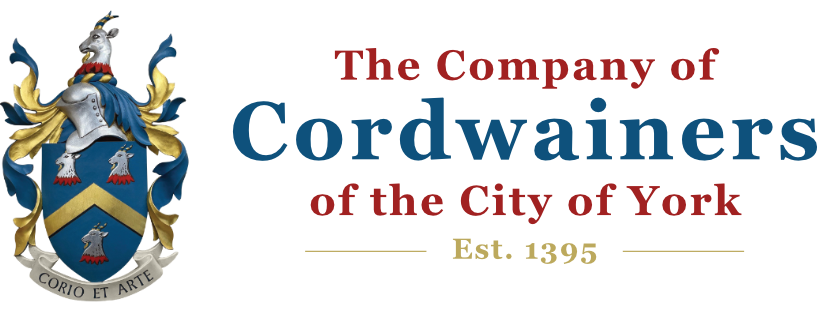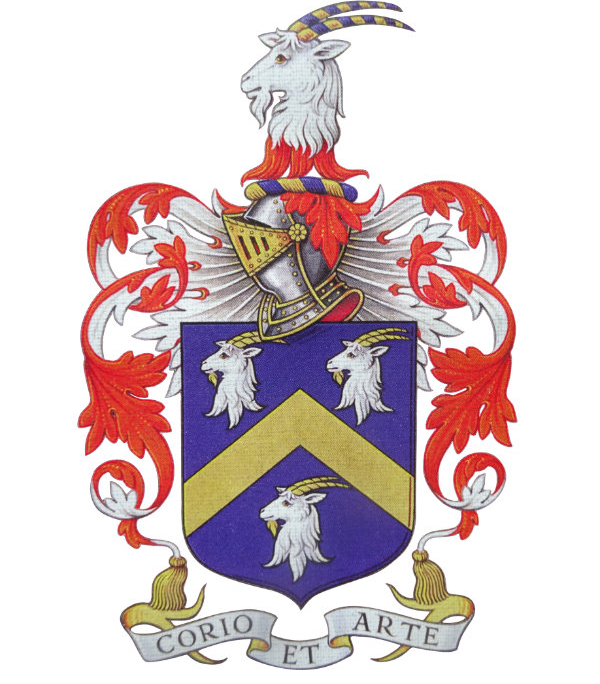Our Company History
The Company of Cordwainers of the City of York is one of the seven ancient guilds which still exist in the 21st century. The medieval guilds have retained many of their traditions which over many years have added greatly to the rich pattern of the city’s history.
The name Cordwainer is derived from ‘cordwan’. History tells us that this was the product of fine leather which came from Córdoba (or Cordova in English) a city in Andalusia, southern Spain. The Moors ruled this area of Spain from the 8th century, which included the city of Cordova and they were skilled workers in the preparation of the skins of mountain goats and kids to create this fine leather. This sought-after commodity eventually found its way to England, probably by the returning Crusaders, ultimately becoming the luxurious material for high-quality shoes and boots in the early medieval period.
Cordwainers should never be confused with ‘cobblers’. Cordwainers make shoes and boots, whereas cobblers only repair footwear. Such confusion has been the cause of many disputes and much anger over the centuries.
The origins of guilds are somewhat obscure, but there is firm evidence of their existence as early as the 12th century. They were first instituted as trade, social and religious groups and those based on trade or business developed into what we would today refer to as employers’ organisations seeking to maintain a monopoly on their business, but also to ensure fair-trading and high standards. A fledgling system of local government emerged through guild representatives who formed the councils and corporations which governed the most important cities and towns of this country.
The earliest reference to the Cordwainer trade in York comes from the Freemen’s Rolls for 1272-3 in which ‘Thomas de Fulford, Cordwainer’ is the first entry. The City of York and the Company of Cordwainers can confidently claim to go back to at least the 14th century. The oldest surviving ordinances of the Company appear in Norman French in the York Memorandum Book c.1395. Later ordinances, dated 1417 and c.1430 appear in Latin in the same book. These ordinances dating from 1395 are currently preserved in the York Minster Archives.
A Cordwainer Apprenticeship
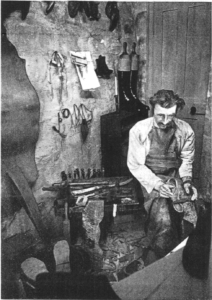
The Cordwainer at Work
The guild of each trade was closely linked to the city’s governance. Anyone wishing to become a cordwainer in the city had to be made ‘free’ by the Company. This entailed serving a seven-year apprenticeship to a Master Cordwainer which then gained the apprentice his ‘freedom through servitude’, or by being the cordwainer’s eldest son, serving a similar apprenticeship, which was known as patrimony. In the case of tradesmen or merchants from out of the city wishing to trade would entail paying a considerable sum, a process of freedom known as ‘franchise’. The main route, however, was through apprenticeship which ensured that young men entering the trade had a good knowledge of working practices of the craft (or mystery from the French word ‘mystere’ which meant trade/craft during the Middle Ages). It is from this concept of ‘keeping secrets’ of the craft that the name of the Mystery Plays came to be as they were a cycle of religious plays performed by the city’s guilds on waggons. The practice of apprentices being bound to their masters was also popular with the city since, in the absence of a police force in the middle ages, the control of a large proportion of the youth of the city was a major advantage.
At the conclusion of his apprenticeship, the pupil cordwainer would have to pass a series of tests set by the Company. By 1622 not only did the apprentice have to ‘cut out the leather for two pairs of men’s and two pairs of women’s shoes and a pair of slippers … but having done so make a handsome dinner for the Company .. and.. provide two bottles of wine to drink the health of His Majesty the King and success to the trade. Then in the afternoon, entertain the Master’s wife, the Searchers’ men, the Pageant Master’s men and apprentices.’
Ten days later the apprentice had to present the finished shoes etc, ‘and make a handsome supper, to provide two bottles of wine and to cut out and make a pair of boots on the spot’. Unbelievably, the apprentice then had to pay the sum of £1 15s. 10d. to be admitted as a ‘free brother’ of the Company. Small wonder that some apprentices extended their training period for years while they saved up for this extravaganza!
The Mazer Bowl
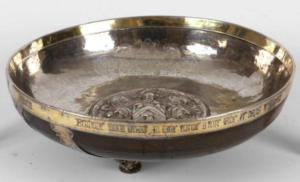
The Cordwainers Mazer Bowl
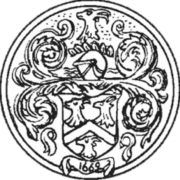
On special Company occasions in later years, spiced ale was drunk from a silver-mounted Mazer Bowl made from very hard mazer wood. The bowl is now the only remaining artefact of the ancient Company. This is now held for safe-keeping in the Minster Library.
The Mazer Bowl was originally made for the Corpus Christi Guild of York at the behest of Agnes Wyman and was presented to that Gild circa 1412, only coming into the possession of the Cordwainers in 1622.
The Weavers Guild Dispute
At the height of the prosperity of the City of York, in the 1400s, there existed up to 80 guilds and companies from the very large, rich and powerful, to the small trades’ guilds. The most powerful was the Weavers Guild, which is curious since we never think of York in terms of a weaving city nowadays. But second in scale of numbers would certainly be the Cordwainers – and that would often cause friction as highlighted later.
The Company of Cordwainers was governed (indeed some old documents refer to the ‘Governor’ of the Cordwainers rather than Master) by the Master and Court of Assistants comprising of Searchers and Pageant Masters. The Searchers were the key officials as they were empowered by the city to enter the premises of tradesmen to check on the quality of work and to ensure that only ‘free brothers’ and their apprentices were being employed and to collect subscriptions due to the company. A major pre-occupation of the Searchers were the cobblers of the city as there was potential areas of overlap between the trades and disputes were frequent. The Pageant Masters had the duty of looking after the waggons and props used by the company to re-enact their play, part of the Mystery Plays performed on the Feast of the Corpus Christi.
A serious dispute arose in the early 15th century between the Weavers and Cordwainers over their respective positions in the Corpus Christi procession, each claiming precedence over the other. Subsequently, the Cordwainers refused to provide the customary 14 flaming torches, claiming that the previously used torches were still quite serviceable. They were then fined £10 by the Lord Mayor and Corporation which the company refused to pay. The Searchers of the Company were then jailed, where they remained for a year and a half. Eventually when the bailiffs seized goods from every cordwainer’s house in the city, the Company reluctantly agreed to pay the fine and the Searchers were released. However, this was not the end of the affair as the Cordwainers petitioned the King who appointed the Abbot of St Mary’s Abbey to mediate between the two guilds. This did little for the Cordwainers as the Abbot ruled that they and the Weavers should take the same position in the procession as before the dispute.
The Decline of Guilds
During the 18th century the importance of all guilds gradually declined and c.1808 the Cordwainers’ Company in York was disbanded. At that time members numbered just 22, 15 of those were the officers and assistants of the court. Curiously, contemporary documents for the city show that there were over 220 cordwainers listed in the records of the day (such as Poll Books). By 1835, with the coming of the Municipal Reform Act, all local government was taken out of the hands of the guilds, and the Lord Mayor and Aldermen were replaced by a democratically elected Corporation.
The Dissolution of the Company
The ancient company was dissolved by the last Master (or Governor) William Hornby, he was a successful shoe-maker to the ‘fashionable elite’ of York and those who were now visiting the city as a place of entertainment and be part of ‘polite society’ by the end of 1700s. It was then that the Mazer Bowl was passed to the Minster for safe-keeping by Wm Hornby, who was an eminent and enterprising York churchman. The Company now have a modern replica which is usually on display at Livery Dinners and other special events.
Unfortunately, the ancient company was left with very little by way of archives or documents on which to draw for the history researcher. The few that were saved were eventually sold to the Minster by the son of Wm Hornby, himself an eminent and clearly enterprising York churchman. However, the dissolution of the ancient company in 1808 was simply dismissed as ‘for reasons unknown’. Research is ongoing as to the circumstances for the dissolution, the disposal of the Shoemakers’ Hall and their lands; the fate of the Shoemakers’ Maison Dieu; and the fortunes of Wm Hornby.
The Re-founded Company
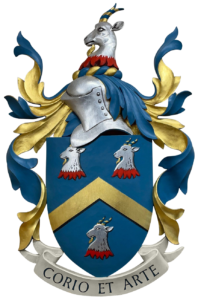 The re-founding of the company was triggered, strangely enough, by the closure in 1970 of a popular coffee house and restaurant. The Creamery on the York street known as Pavement, was a venue for wedding receptions and meetings with a room called The Gild Room with walls decorated with plaques of the arms of the ancient city guilds. When the restaurant closed, the plaques were presented to those guilds that still existed. The Cordwainers was not one of them. However, the late Bernard Johnson, Archivist to the Company of Merchant Adventurers’, collected them all together and presented them to the Guild Church of All Saints Pavement on the 29th October 1972, where they hang to this day on the south wall. It is unexplained why, but one of the shields was that of our ancient Company and this was given to Mr Percy Nutt, who then worked at Cox’s of Northampton, a well-known leather shop in the Shambles in York. He then presented the shield to All Saints Pavement on the 3rd November 1974 to join the others on the wall.
The re-founding of the company was triggered, strangely enough, by the closure in 1970 of a popular coffee house and restaurant. The Creamery on the York street known as Pavement, was a venue for wedding receptions and meetings with a room called The Gild Room with walls decorated with plaques of the arms of the ancient city guilds. When the restaurant closed, the plaques were presented to those guilds that still existed. The Cordwainers was not one of them. However, the late Bernard Johnson, Archivist to the Company of Merchant Adventurers’, collected them all together and presented them to the Guild Church of All Saints Pavement on the 29th October 1972, where they hang to this day on the south wall. It is unexplained why, but one of the shields was that of our ancient Company and this was given to Mr Percy Nutt, who then worked at Cox’s of Northampton, a well-known leather shop in the Shambles in York. He then presented the shield to All Saints Pavement on the 3rd November 1974 to join the others on the wall.
Percy Nutt then discussed the idea of reforming the Company of Cordwainers with Canon John H. Armstrong of All Saints Pavement and the Chaplain to all the York guilds. After a meeting on 1st March 1977, a decision was taken to re-form the Company with the first Master being Percy Nutt. In fact he held the office of Master for the first two years. A Masters list since 1977 can be found on this website.
The Master & Court of Assistants
In accordance with tradition, and in normal circumstances, the present day company is governed by the Master who holds office for one year presiding over a Court of Assistants. The officers of the Company include Master Elect, Elder and Junior Searchers (the titles based on seniority within the company rather than on age), and Pageant Masters. There is a Chamberlain (Hon. Treasurer), Clerk, Deputy Clerk, Beadle (Master of Ceremonies), Dinner Clerk, Almoner and Archivist. The only paid officer is the Beadle who receives an annual stipend of £1 per year!
The Charter Weekend
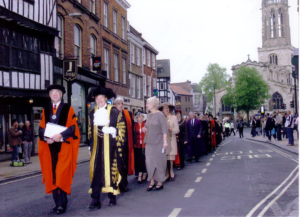
Charter Weekend procession from All Saints Pavement Church to Bedern Hall
The present-day Company has a programme of social events which culminates with The Livery Dinner, held as part of the Charter Weekend on a Saturday and Sunday early in May. The new Master is installed prior to the formal dinner followed by the induction of new members into the Company. On the Sunday there is a procession to the guild church (All Saints Pavement) which is usually attended by the Civic Party and Masters of other guilds and companies of York, London and other cities in England and Scotland. After the church service there is a procession, traditionally headed by the Rt. Hon. The Lord Mayor of York and the new Master to Bedern Hall the home of the Company of Cordwainers of the City of York.
